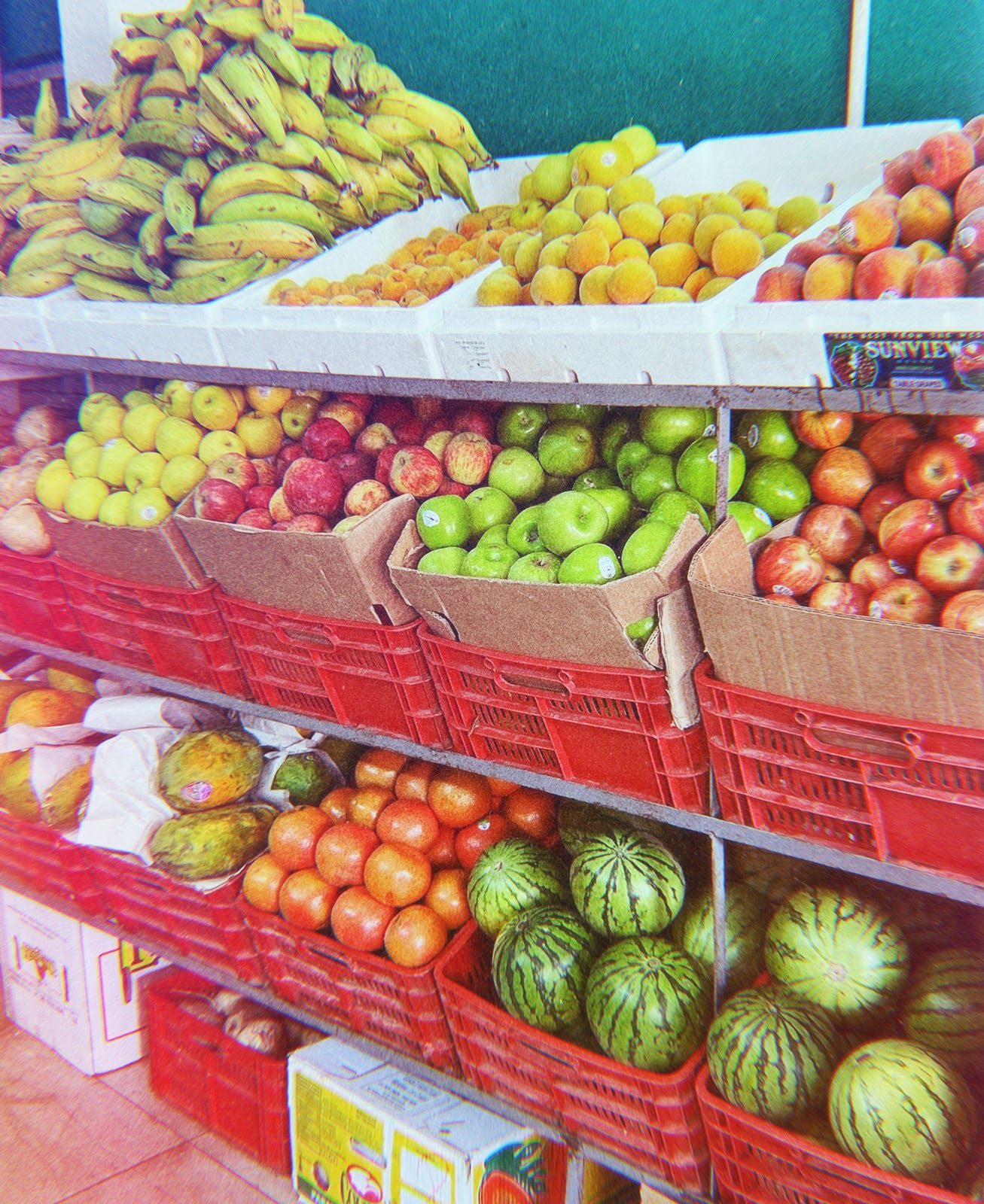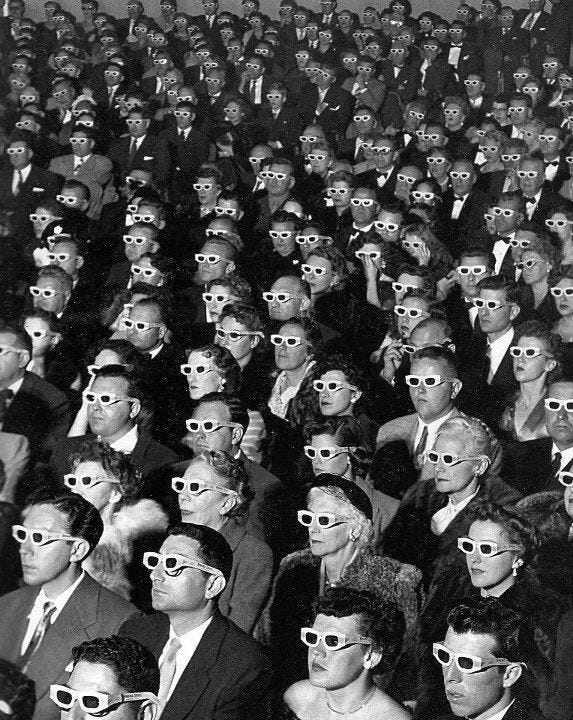Content & the orchards of origin
Following back and honoring the thread of life in all we consume
I walk into tiny corner markets and sprawling grocery stores alike along the Pacific coast of Mexico, and in every shop I make a bee line for the produce section to search for and collect my week’s worth of breakfast: Granny Smith apples, tart and crisp little nuggets that I’ll smear with a bit of salty peanut butter and crunch on, standing barefoot in the galley that’s golden with morning sun.
I'm always surprised to see these apples in all of these markets, though I always hope they’re there. And it’s often not just a handful that I find, but rather piles — mountains — of Granny Smiths spilling over in crates that are sitting among other oversize crates that are also spilling over with various fruits and vegetables.
The sheer volume of food in any local supermarket is always astounding and something I never overlooked. But as we sail our way around the world and visit new stores in each new town, it has become even more apparent and striking just how much food is being produced on our planet. And not just once, of course, but all the time, refilling shelves and baskets and refrigerators and pantries and bellies every day, every week, every year, for eight billion bodies to consume for every meal for their whole life, ad infinitum. (That not actually every body everywhere has unbridled access to these mountains of food is its own perplexing tragedy far beyond the scope of this essay).

I love those apples. But I also recognize just how ridiculous an item it actually is to hope for, let alone to find here. More often than not, the stickers on them reveal their orchard of origin as somewhere in Washington state, where we sailed out of a year and a half ago. I think about all it took to get me here from there, let alone endless crates of perishable little fruit, day after day, week after week.
And yet they’re here. But of course they’re here. Because this perpetual and boundless availability is a feature woven into nearly all aspects of modern life.
The correlation between eternal access to basically every type of food imaginable, regardless of any geographic constraint or earthly season, and the physical and psychological distance between humans and the source of all that sustains their modern life is hardly a novel observation to announce. But growing inside this yawning void between us and the sources of our food, is something to watch for: an expectation.
Oblivious and often unconcerned as to how, our market's shelves and our pantries just get filled. It all just… appears. Everywhere, always. And moreover, we expect it will appear, everywhere, always. And all that’s required of us is a walk to the market to greet the colorful piles with our eyeballs, and a few bucks to take some home. So why concern ourselves too much over everything it took to make this bounty just a stroll away, available day after day?
This expectation is probably innocent enough most of the time, born of regularity and predictability, and I’m not sure it is in itself a problem — but I am sure that it’s critical to keep a watchful eye on, so we can catch it the moment it begins to morph into its not-so-innocent twin: entitlement.
This is when we see apples, for example, as something that we take and consume with no awareness of or gratitude for the infinite layers of lives involved or the immense cost the earth bore to bring that apple to our fingertips.
Robin Wall Kimmerer’s entire gorgeous book, Braiding Sweetgrass, is a meditation on this common modern-day imbalance and misunderstanding, helping us to rectify it through the lens of indigenous wisdom. There is no symmetry, no reciprocity, no relationship, between most humans and the land on which we walk, the land that feeds and shelters and heals and clothes and holds us, the land that literally birthed us.
We are showered every day with the gifts of the Earth: air to breathe, fresh water, the companionship of geese and maples—and food. Since we lack the gift of photosynthesis, we animals are destined by biology to be utterly dependent upon the lives of others, the inherently generous, more-than-human persons with whom we share the planet.
If we understand the Earth as just a collection of objects, then apples and the land that offers them fall outside our circle of moral consideration. We tell ourselves that we can use them however we please, because their lives don’t matter. But in a worldview that understands them as persons, their lives matter very much. Recognition of personhood does not mean that we don’t consume, but that we are accountable for the lives that we take. When we speak of the living world as kin, we also are called to act in new ways, so that when we take those lives, we must do it in such a way that brings honor to the life that is taken and honor to the ones receiving it.
The canon of indigenous principles that govern the exchange of life for life is known as the Honorable Harvest.
She recounts a trip to a mall:
As leeks cannot survive in a clear cut forest, the Honorable Harvest cannot survive in this habitat. We have constructed an artifice, a Potemkin village of an ecosystem where we perpetrate the illusion that the things we consume have just fallen off the back of Santa’s sleigh, not been ripped from the earth. The illusion enables us to believe that the only choice we have is between brands.
She writes later,
What would it be like, I wondered, to live with that heightened sensitivity to the lives given for ours? To consider the tree in the Kleenex, the algae in the toothpaste, the oaks in the floor, the grapes in the wine; to follow back the thread of life in everything and pay it respect?
This illusion, this utter indifference of the cost and source of all we consume served with a side of entitlement-flavored expectation, has bled beyond the boundaries of our physical landscape and the products we buy and the food that we eat. It’s one I’ve been watching and studying closely in the digital realm: the landscape of content.
We are far more awash in content than we are in produce and products, which, as I think of the actual bottomless pit of Amazon or the overfilled crates of produce in every store everywhere right now, is actually pretty astounding to consider. And we don’t even have to stroll to the corner market to tap in, and we don’t need to fork over a dime. We just reach in our pocket.
We can follow the thread of life back from the apples we eat at least to an approximate degree, and as Kimmerer suggests, pay that entire thread respect. Giving it a moment of our attentive consideration can help us to shift from mindlessly consuming a commodity into a more intentional exchange with not only the foods we eat and love, but with the infinite layers of life that are involved in allowing us to keep ours, and ultimately with the earth itself.
But how do we follow the thread of life back to the sources of content we consume? Should we even try? What does that even mean?
The contentverse is… vast. Some of it is churned out by massive corporations, much (most?) of it is advertisements, and an increasing amount of it is (and will be) made by AI, like ChatGPT. Just like food or goods, not all content is created equal, and perhaps these are the equivalent of plastic: there’s no real life to be found here, and honor, at all.
But I still think the question deserves some thought.
Because behind the digital content that remains — the personal essays and articles that move us, the videos and podcasts that teach us something of value about how to live more efficiently or meaningfully, the stories and wisdom shared from one human to another, the music and writing and photographs that punctuate our best and worst moments alike — is a life lived.
The “content” we actually value, resonate with, and grow from is a product pulled and plumbed and produced from of our most human parts and depths: pain and rage and joy and grief and connection and confusion and clarity and evolution. Countless lessons learned and processes unearthed and examined, all privately experienced and carefully constructed into a publicly consumable bitesized bit, for our collective enjoyment and pleasure.
It used to be, for most of our existence as a species, that we could only enjoy apples in certain locations and seasons, and we would only have access to a handful of books, stories, or performances at a time — and as such we received these gifts of the earth and of the mind with the reciprocal gifts of our full interest, attention, and reflection. But our modern abundance and perennial accessibility has, once again, begun to distance us from the source, shifting the tone between all we consume and where it comes from.
Maria Popova, a writer who shares impressively researched and thoughtful, beautiful pieces freely and weekly to her email list, recently added this salient post script in a newsletter:
As a society, we have ceased thinking about how cultural matter appears before us — we take it for granted that we will be informed, entertained, perhaps even enchanted, with nothing required of us in kind. We call this cultural matter by the slur under which Silicon Valley has commodified it: “content” — something to fill the empty the screen, of the hollow life, insentient to the human endeavor behind it, the myriad invisible labors and sacrifices, collaborations and lonelinesses that make anything of beauty and substance come alive.
Oblivious and often unconcerned as to how, our news feeds just get filled. We expect it all to be there. In our pockets, available at our disposal whenever we like, and always entirely free of charge.
We inhale piece after piece, leaving no moment for digestion or reflection. We scroll, listen, watch, and read like Lucy in the chocolate factory, becoming buried in goods that we try to keep up with at a rate that does nothing but diminish the true intellectual and emotional valence of any given work and continues to extend the distance and awareness between all that we are consuming and the orchard of creative origin from whence it came.
We couldn’t care less about the complex, slow, underground process of personal metamorphoses — seed to sapling to fruit to fruition to our fingertips — uninterested in the entirely required and often messy maturing within someone else that makes any piece of content possible, let alone meaningful or interesting to us. It all just appears, seeming to fall “off the back of Santa’s sleigh”, and we scroll on.
I have consumed content mindlessly, and still do — I am by no means exempt from this all-too-easy to fall into pattern. But I’m making an effort these days to look closer, to slow down, to honor and recognize the personhood behind the work from which I, from which we all, benefit.
Just as we physically rely on the lives of others for our own, we rely just as heavily on the lives of other humans to improve and understand our own. Today we sit high upon the throne of collective, cumulative wisdom — benefitting in every way from every idea that anyone has ever documented since documenting (content creating?) began. We are the only species who has the accumulation of eons of human life, intellect, history, struggle and triumph at our disposal. “Content” through this lens, is a gift.
We can see this all more clearly with the development of ChatGPT: the first “content” made by AI that is actually devoid of the human experience once required to create it. Nick Cave explains why a song generated by OpenAI, on the prompt of a fan to imitate Cave’s style, “sucks”:
ChatGPT has no inner being, it has been nowhere, it has endured nothing, it has not had the audacity to reach beyond its limitations, and hence it doesn’t have the capacity for a shared transcendent experience, as it has no limitations from which to transcend.”
The human being behind the work is the difference between information and wisdom, between a melody and magic. And I believe we would benefit to remember this.
“Content” can be a thing to fill the void, a faceless commodity to scroll through, a mountain of information always available to us that sits below the bounds of “moral consideration”. A lot of it is noise and a distraction. But it can also, like berries and bluejays and birch trees, be a gift.
It’s a beautiful thing that most people now have access to apples all of the time, for a small fee. It’s an incredible thing that most people now have access to the entirety of human wisdom in their pocket, for free. Both of these are pretty much indisputable advances for which we are all on average, better off. We should be able to enjoy these perks of modernity.
But maybe becoming a more conscious “consumer” might look like not being a consumer at all, but rather becoming one part of an awake exchange with the riches we are offered and rely on in this world, seeing both fruit at the market and the fruits of others’ intellectual or emotional creations as gifts, and responding in kind. Making our choices more carefully, putting our cherished dollars where it counts, putting our valuable attention where it counts, slowing down to savor, giving gratitude, and watching for when expectation subtly shifts into the zone of entitlement. And maybe as a more conscious creator of content, we can choose more carefully the platforms we publish on, opting for slow moving free range spaces over industrialized factory farms.
Content: the images, sounds, and language — the purest distillations and expressions of life itself — crafted through the wrenching process of being, packaged neatly and extended outward, is a gift from one human to another, bringing shape and light and dimension to the very step we find ourselves taking next.
Recognizing the real breathing body behind the digitized glare of the glowing screen is a practice that might connect us back to who we really are, something that connects us to the shared experience of who we all are.
xo
Taylor
P.S. Know someone who might enjoy this? If you’re reading in your inbox, feel free to forward it on. Please share! :)
What would it mean to be a conscious consumer of content? Or even a more conscious creator of content? I’d love to hear your thoughts!





